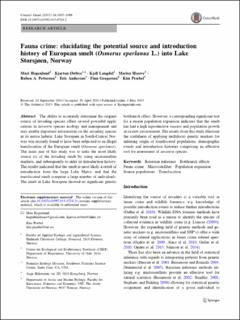| dc.contributor.author | Hagenlund, Mari | |
| dc.contributor.author | Østbye, Kjartan | |
| dc.contributor.author | Langdal, Kjell | |
| dc.contributor.author | Hassve, Marius Hagen | |
| dc.contributor.author | Pettersen, Ruben Alexander | |
| dc.contributor.author | Anderson, Eric | |
| dc.contributor.author | Gregersen, Finn | |
| dc.contributor.author | Præbel, Kim | |
| dc.date.accessioned | 2022-08-15T12:37:19Z | |
| dc.date.available | 2022-08-15T12:37:19Z | |
| dc.date.created | 2015-05-04T08:42:55Z | |
| dc.date.issued | 2015 | |
| dc.identifier.citation | Conservation Genetics. 2015, 16 (5), 1085-1098. | en_US |
| dc.identifier.issn | 1566-0621 | |
| dc.identifier.uri | https://hdl.handle.net/11250/3011900 | |
| dc.description.abstract | The ability to accurately determine the original source of invading species offers several powerful applications in invasive species ecology and management and may enable important information on the invading species in its native habitat. Lake Storsjøen in South-Central Nor way was recently found to have been subjected to an illegal translocation of the European smelt (Osmerus eperlanus). The main aim of this study was to infer the most likely source (s) of the invading smelt by using microsatellite markers, and subsequently to infer its introduction history. The results indicated that the smelt is most likely a result of introduction from the large Lake Mjøsa, and that the translocated smelt comprise a large number of individuals. The smelt in Lake Storsjøen showed no significant genetic bottleneck effect. However, a corresponding significant test for a recent population expansion indicates that the smelt has had a high reproductive success and population growth in its new environment. The results from this study illustrate the usefulness of applying multilocus genetic markers for inferring origin of translocated populations, demographic events and introduction histories comprising an effective tool for assessment of invasive species | en_US |
| dc.language.iso | eng | en_US |
| dc.relation.uri | http://link.springer.com/article/10.1007/s10592-015-0724-2?wt_mc=event.ArticleAuthor.OnlineFirst | |
| dc.rights | Navngivelse 4.0 Internasjonal | * |
| dc.rights.uri | http://creativecommons.org/licenses/by/4.0/deed.no | * |
| dc.subject | Bayesian inference | en_US |
| dc.subject | Bottleneck effects | en_US |
| dc.subject | Fauna crime | en_US |
| dc.subject | Microsatellites | en_US |
| dc.subject | Population expansion | en_US |
| dc.subject | Source populations | en_US |
| dc.subject | Translocation | en_US |
| dc.title | Fauna crime: elucidating the potential source and introduction history of European smelt (Osmerus eperlanus L.) into Lake Storsjøen, Norway | en_US |
| dc.title.alternative | Fauna crime: elucidating the potential source and introduction history of European smelt (Osmerus eperlanus L.) into Lake Storsjøen, Norway | en_US |
| dc.type | Peer reviewed | en_US |
| dc.type | Journal article | en_US |
| dc.description.version | publishedVersion | en_US |
| dc.subject.nsi | VDP::Matematikk og Naturvitenskap: 400 | en_US |
| dc.source.pagenumber | 1085-1098 | en_US |
| dc.source.volume | 16 | en_US |
| dc.source.journal | Conservation Genetics | en_US |
| dc.source.issue | 5 | en_US |
| dc.identifier.doi | 10.1007/s10592-015-0724-2 | |
| dc.identifier.cristin | 1240203 | |
| dc.relation.project | Norges forskningsråd: 179569 | en_US |
| cristin.ispublished | true | |
| cristin.fulltext | original | |
| cristin.qualitycode | 1 | |

